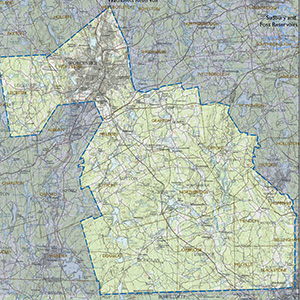Important Bird Area Sites in Massachusetts
Important Bird Area: Blackstone River Valley National Heritage Corridor
Site Summary
Nominated By
John Liller, Mark Lynch, Sheila Carroll
Size
250,000 acres
Towns and Counties
Blackstone, Douglas, Grafton, Hopedale, Leicester, Mendon, Millville, Northbridge, Upton, Uxbridge, Sutton, Worcester; Worcester County and 8 Rhode Island towns
Ownership
state, federal military, municipal, private, nongovernmental organization
Major Habitats
oak-conifer transitional forest, early successional shrubland, cultural grassland, cultivated field, emergent freshwater wetland, shrub-scrub wetland, marine/tidal, lake/pond, river/stream, urban/suburban
Land Use
nature & wildlife, conservation/ land trust, hunting & fishing, other recreation, water supply, quarry/gravel pit, suburban/residential, urban/industrial/commercial
Serious Threats
invasive or non-native plants, introduced animals/feral pets, deforestation, water/air pollution, habitat conversion, disturbance to birds or habitat
Minor Threats
cowbird parasitism, extraction industry, recreation, development/overuse
IBA Criteria
- Category 1: Land Birds: The site is an important migratory stopover or seasonal concentration site for migratory land birds (e.g., warblers). Sites may also qualify on the basis of supporting exceptionally high densities of breeding species as shown from point counts or other surveys or if they represent "migrant traps" relative to surrounding areas. Strong consideration will be given to areas with consistently high overall species diversity...
- Category 2: Waterfowl: The site regularly supports 500 or more waterfowl at any one time. The designation "waterfowl" includes birds such as loons, grebes, cormorants, geese, ducks, coots, and moorhens.
Site Description
Though officially designated as a National Park Service (NPS) site, the federal government does not own or manage the Blackstone Corridor as it does most other National Parks. Instead, people, businesses, nonprofit historic and environmental organizations, and the NPS work together on a commission that makes decisions for the Corridor. The Corridor generally includes most of the watershed of the Blackstone River, which flows 46 miles from the city of Worcester in Massachusetts to the Corridor's terminus at India Point in Providence, Rhode Island. Here the Seekonk River flows into the Providence River. The entire area is of major historic significance. It was at Slater's Mill, Pawtucket, that the Industrial Revolution began. Mills and other regionally-important industries popped up all along the Blackstone. By the early 1900s, the Blackstone was known as the nation's "hardest working river" and, unfortunately, was also among the most polluted and exploited. By the 1940s, many of the mills were closed and several of the towns went into economic decline.
Local interest in cleaning up the river and turning many of the areas along its length into parks has been growing in the last decades. With the declaration of the area as a National Corridor, many projects to improve the water quality, land use, and appreciation of the river are well under way. Mass Audubon at Broad Meadow Brook is one of the key players in developing an environmental appreciation of the Corridor as well as a leader in the ecological education of the area.
The Corridor generally follows the Blackstone River watershed. Several new parks have been created along the river's length and throughout the Corridor, with an emphasis on natural beauty as well as history. More parks are to be built, including a large park in southern Worcester. The overall effect is to create an emerald necklace between Worcester and Providence. The area is very developed, with major cities including Worcester, Woonsocket, Pawtucket and Providence. The area of the Corridor in the Massachusetts section is hilly, with numerous ponds and reservoirs. Many of these ponds are used by migrating waterfowl. In Rhode Island, the northwestern section of the Corridor is the hilliest part. Significant marshes exist in several sections of the Corridor along the Quinsigamond River and its tributaries, and there are several smaller cattail marshes in areas such as Cumberland. Important grasslands include the Worcester Airport and Worcester Landfill, containing the only population of Grasshopper Sparrows in the Corridor.
Current Conservation Status
The centuries-long abuse of the Blackstone River is well documented. The challenge to clean the river up is daunting, but is being tackled head-on. A federal study of methods for removing heavy metals contained in the mud and silt of the riverbed is currently underway. Elimination of point-source pollution of the river is an ongoing project. Results have been promising, if slow.
Much of the area has been long urbanized and suburbanized, but large tracts of mixed forest remain in several locations, many of which have been declared parks, state forests, or wildlife management areas. However, detrimental recreational use, especially by all-terrain vehicles, poses a threat throughout the Corridor and particularly in the Rhode Island sections. Slowing the course of development of the remaining small woodlots and grasslands is of serious concern.
Along with the development of the riverbanks, much of the surrounding land is urban or suburban. Pollution and abuse in these areas is inevitable, but needs constant monitoring. One of the biggest challenges is to educate diverse urban populations on how to appreciate and enjoy their natural resources.
Ornithological Significance
The entire Corridor provides an exciting possibility for an education and research-based IBA for the following reasons. The Blackstone River is a natural pathway from the southern coast into central New England. Every summer, numbers of Black-crowned Night-Herons appear in Worcester. The origins of these birds are breeding colonies in southern Narragansett Bay, Rhode Island. In the city of Worcester, six years' of waterfowl surveys have shown that large numbers of migrant waterfowl utilize the urban ponds and lakes. In 2001, a more systematic survey of all the significant lakes and ponds in the Corridor was conducted. Early results show large numbers of: Canada Goose (607), Mallard (714), American Black Duck (222), Ring-necked Duck (233), Common Merganser (143), Hooded Merganser (114), Ruddy Duck (99) (Massachusetts totals). Common Nighthawks migrate through the Corridor in significant numbers and have been counted for decades (1,000+ annually). Several areas in the Corridor are known as migrant land bird hot spots. These include Swan Point Cemetery in Providence and Mass Audubon's Broad Meadow Brook Wildlife Sanctuary in Worcester. Forster's Terns (354 in 2001), Common Terns, and Laughing Gulls were observed feeding in the Seekonk River. Ospreys nest at several locations along the lower stretches of the Corridor. The Uxbridge and part of the Worcester Christmas Bird Counts and Breeding Bird Surveys occur within Corridor limits. Because the area is designated a National Corridor many organizations are involved with Corridor projects, and several monitoring projects have been implemented. Some state and federally listed, and many high conservation priority species, are recorded as utilizing the Corridor, including the Bobolink, Eastern Meadowlark, Black-crowned Night-Heron, Worm-eating Warbler, Black-throated Green Warbler, Canada Warbler, and Louisiana Waterthrush.
Other Flora or Fauna of Significance
Many species are now being cataloged. The Hessel's Hairstreak has been found in Douglas State Forest. Plans to construct fish ladders for anadromous fish are in progress.
Data Sources
BBS, CBC, M. Lynch, Personal observations. All records for 2001 sent to both Bird Observerand Rhode Island Bird Records, both published bimonthly.




